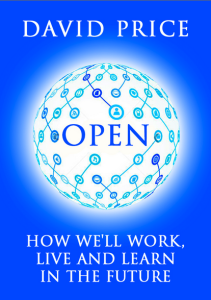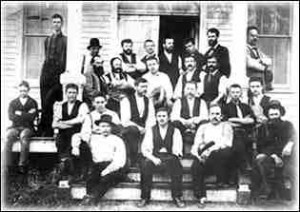 As my book ‘OPEN’ is published this week, I thought I’d post something about what we can learn from great learning environments. In a book which focusses very much on current organisational and educational settings, it may seem unusual to look back to the late 19th century. But Thomas Edison’s Menlo Park complex remains one of the finest examples of a dynamic learning environment. The stats alone are impressive – over 400 patents filed in 6 years. Despite this, Edison asked to be judged, not on his successes, but by the number of experiments carried out each day.
As my book ‘OPEN’ is published this week, I thought I’d post something about what we can learn from great learning environments. In a book which focusses very much on current organisational and educational settings, it may seem unusual to look back to the late 19th century. But Thomas Edison’s Menlo Park complex remains one of the finest examples of a dynamic learning environment. The stats alone are impressive – over 400 patents filed in 6 years. Despite this, Edison asked to be judged, not on his successes, but by the number of experiments carried out each day.
This was no solitary wizard – his ability to find and attract talent, and his skill in creating a dynamic learning environment was Edison’s real genius. What can we learn from the culture and structure of Menlo Park? I believe there are five key lessons:
1. Create A Machine-Shop Culture
Menlo Park was known as the ‘inventions factory’. Its naming was intentional, bringing together the head (having the idea) and the hands (making it work) – creativity and craftsmanship. Edison fashioned a learning culture where head and hands were equals. In doing so, he imported the practices he’d seen in the machine shops in Newark, New Jersey. However, in addition to affording equal respect to intellectual and practical pursuits, there are values you’d want to have in place, if you want to build a machine-shop culture:
a) Create A Democratic Learning Commons – Looking at photographs taken inside the machine shop at Menlo Park, it’s virtually impossible to tell which one is Edison. ‘Lead experimenters’ held no particular authority over ‘muckers’. Edison knew that good ideas could come from anywhere, and that creativity hates hierarchy.
b) Encourage Unorthodoxy – The rigid working practices emerging through the industrial age, held no attraction to Edison or his workers. ‘Nine-to-five’ frequently meant working through the night and sleeping the following day. Acutely aware that they were making history, the culture had to foster counter-intuition.
c) Welcome Diversity – Edison consciously created machine shops where a diverse range of skill sets worked in the same room.
d) Learn by Tinkering – MIT, Google and Edison Labs are all examples of ‘inventing by doing’. Great machine-shop companies live and breathe tinkering philosophies, as can be seen in their company axioms. For Google, ‘everything is in beta’ and employees ‘fail fast and iterate’, while Edison maintained ‘I have not failed. I’ve just found 10,000 ways that won’t work.’
2. Keep It Social
As we see more widely now, the dividing line between work and play is often deliberately blurred in intensively creative workplaces. The remarkable thing about Menlo Park, however, is that the general public was encouraged to join the commons: “The shops were places to socialise as well as work. Visitors were allowed easy access to the shops, whether they were men looking for work, boys looking for amusement, or amateur inventors looking for new ideas.” We’re increasingly seeing companies become social businesses – working with employees, partners, suppliers, and customers to ‘maximise co-created value’. More and more business are coming to see that a business that’s social, is not just a better way of connecting with customers, it’s a route to better employee engagement.
3. Make learning horizontally relevant
‘Horizontal relevance’ is a term coined by Lilian Katz to denote learning that is relevant because it solves a problem I have now, not at some unspecified point in the future (which she deemed’ vertical relevance’). In the Edison Labs every experiment, every ‘learning moment’ was trying to solve the problem immediately facing Edison and his muckers. Suppositions weren’t filed away for later development. They were tested, however late the hour, there and then, in what Marcia Conner calls ‘the moment of need’.
4. Give learners the ‘right-to-roam’ on the commons
A true learning commons needs to give learners the right-to-roam, if only for some of their time. At Menlo Park, the practice of moving between projects was known as ‘tramping’. Workers were encouraged to work on a number of projects at once, rotating between them, when their expertise was needed, or when they thought they had something to offer. Critically, tramping doesn’t just expand the learning of individual employees – it ensures that knowledge doesn’t remain within silos, but circulates throughout the organisation.
5. From individual to collective, from formal to informal
Most businesses still focus upon individual learning, but what we see in great learning organisations is a shift towards the collective knowledge of the company. Social media has transformed the ‘reach’ of knowledge availability exponentially. This means that learning managers have quickly gone from ‘how do I get the answer into your head?’ to ‘maybe the answer’s in the room’ to ‘the answer’s not even in the room, it’s in the network’. Forget e-learning – the concept of Personal Learning Networks, facilitated through social media, is the biggest disruptive innovation to have hit workplace learning in 50 years. Here, however, is the paradox in going ‘open’: organisations are beginning to see that they need to become intentional about informal learning, and, in particular, social learning. A transition to more informal learning has to be managed, and they have learning officers to do just that. But, for informal learning to be effective, it depends on pull, not push. So leaders increasingly need to create the right growing conditions (culture and structure) sprinkle some seeds, and see what comes up, rather than imposing social learning on their businesses.
OPEN: How We’ll Work, Live and Learn In The Future is available to download from Amazon, from October 6th




This truly resonates. Creating a mchine shop culture, tinkering and learning…we need this in every school.